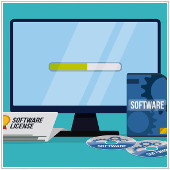The Chromebook has been on the market since 2011. While back then many people scoffed at the idea of buying a laptop made predominantly for internet use, with the rise of cloud computing these days, it now looks like more of a viable option for businesses. So how do you know whether or not a […]
 The Chromebook has been on the market since 2011. While back then many people scoffed at the idea of buying a laptop made predominantly for internet use, with the rise of cloud computing these days, it now looks like more of a viable option for businesses. So how do you know whether or not a Google Chromebook is right for your organization? Well, it all depends on your unique needs and circumstances. Let’s have a look.
The Chromebook has been on the market since 2011. While back then many people scoffed at the idea of buying a laptop made predominantly for internet use, with the rise of cloud computing these days, it now looks like more of a viable option for businesses. So how do you know whether or not a Google Chromebook is right for your organization? Well, it all depends on your unique needs and circumstances. Let’s have a look.
Buy a Chromebook if you…
Are on a budget: With a range of models available between the prices of $199-$500, Chromebooks are incredibly affordable. That is far cheaper than any Apple laptop and more competitively priced than most PC offerings. So if budget is a concern, then consider a Chromebook.Want a high-powered laptop: Just because Chromebooks are affordable, doesn’t mean they’re of less quality. In fact many Chromebook features are better or on par with their PC and Apple counterparts. Here are a few notable ones worth mentioning.
- Long battery life: When it comes to battery life and laptops, Chromebooks are among the best of the best. On average, a Chromebook can supply anywhere from 6-13 hours of battery life.
- Speed: Chromebooks boot up remarkably fast. Once you press the power button, your Chromebook can be ready to go in 8-20 seconds.
- Lightweight: While weight varies among the various Chromebooks on offer, most are incredibly lightweight and easy to pack with you when you’re on the go.
- Security and auto-updates: Not only is malware and virus protection baked into the Chrome OS, but with a Chromebook you’ll never have to worry about updates as they’re all taken care of automatically - silently in the background.
Avoid a Chromebook if you...
Rely on desktop applications - As mentioned above, Chromebooks are meant to be used with the internet. Because of this, powerful desktop applications like Photoshop and advanced video editing apps are incompatible on it.Work mostly without an internet connection - We’ve mentioned it several times already, but it’s worth mentioning again, DO NOT buy a Chromebook if most of your work is done offline. Even if you bought an entry-level Chromebook for $200 and feel like you got a great deal, it will be a useless piece of metal if you need it to complete offline work.
Are a Microsoft junkie - If you are heavily reliant on Microsoft products you may want to look elsewhere for a laptop. Google promotes the use of its own online suite of Office-like applications. And while they are similar to Microsoft products, they do lack some of the features you may love.
For those still on the fence about whether or not a Chromebook is the right choice for their business, it’s also worth noting that just last month Google announced they’ll be adding Android apps to Chromebooks. So if you’re already an Android phone or tablet user, later this year you’ll be able to use those same apps on your Chromebook.
Want to know more about Chromebooks and other laptop options? Our experts are here to help you make an educated purchase. Call us today, and we’ll be happy to share our wealth of information.

 Whether you only need a dozen, or a hundred, the process of deciding on and acquiring software licenses can be very frustrating. Many of us had hoped that cloud computing and virtualization would alleviate some of these headaches. Unfortunately, we’re not there yet, which is why it’s important to understand all of your licensing options when deciding on a virtualized environment -- let’s take a look.
Whether you only need a dozen, or a hundred, the process of deciding on and acquiring software licenses can be very frustrating. Many of us had hoped that cloud computing and virtualization would alleviate some of these headaches. Unfortunately, we’re not there yet, which is why it’s important to understand all of your licensing options when deciding on a virtualized environment -- let’s take a look.
 You may think that you hate slideshow-based presentations, but in reality you probably hate poorly designed content and overapplication of transition effects. The recent update to Google Slides may not have removed your most dreaded cliche, but they did add some truly innovative interactivity features. Let’s take a closer look at this great new feature.
You may think that you hate slideshow-based presentations, but in reality you probably hate poorly designed content and overapplication of transition effects. The recent update to Google Slides may not have removed your most dreaded cliche, but they did add some truly innovative interactivity features. Let’s take a closer look at this great new feature.
 In this day and age almost every business employs some type of server management. If yours is hosted locally, temperature management could mean the difference between running smoothly and running into the ground. Understanding how to properly cool your servers prevents data loss and ensures the longevity of your hardware’s life.
In this day and age almost every business employs some type of server management. If yours is hosted locally, temperature management could mean the difference between running smoothly and running into the ground. Understanding how to properly cool your servers prevents data loss and ensures the longevity of your hardware’s life.